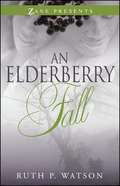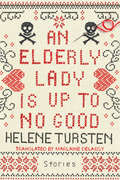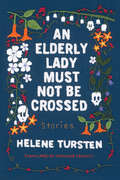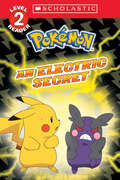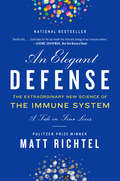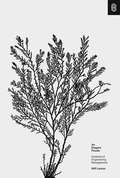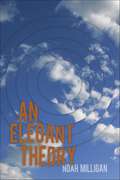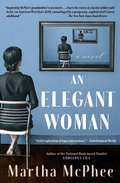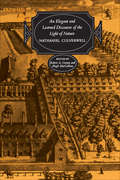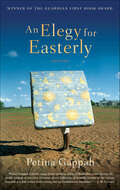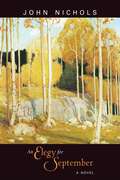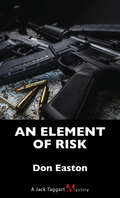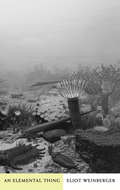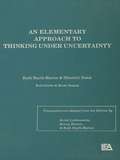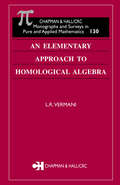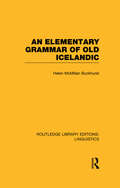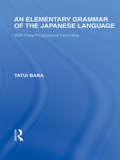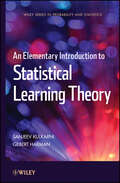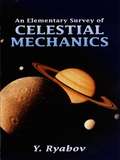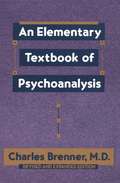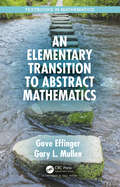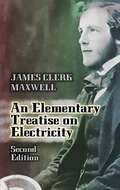- Table View
- List View
An Elastic Model for Volcanology (Lecture Notes in Geosystems Mathematics and Computing)
by Andrea AspriThis monograph presents a rigorous mathematical framework for a linear elastic model arising from volcanology that explains deformation effects generated by inflating or deflating magma chambers in the Earth’s interior. From a mathematical perspective, these modeling assumptions manifest as a boundary value problem that has long been known by researchers in volcanology, but has not, until now, been given a thorough mathematical treatment. This mathematical study gives an explicit formula for the solution of the boundary value problem which generalizes the few well-known, explicit solutions found in geophysics literature. Using two distinct analytical approaches—one involving weighted Sobolev spaces, and the other using single and double layer potentials—the well-posedness of the elastic model is proven. An Elastic Model for Volcanology will be of particular interest to mathematicians researching inverse problems, as well as geophysicists studying volcanology.
An Elderberry Fall
by Ruth P. WatsonThis sequel to the historical bestseller Blackberry Days of Summer reunites the people of Jefferson County, Virginia, with yet another murder and the resurrection of an evil thought to be dead and gone.As she adjusts to a new beginning in Richmond, Virginia, Carrie Parker finds herself juggling motherhood, work, school, and increasing strains on her new marriage to Simon. Carrie and Simon are happy parents, but sometimes Carrie feels there's something dark and evil about her little baby's eyes, and it scares her. She vows he will not be anything like his real father--a beady-eyed womanizer now long gone. But the past has a strange way of creeping back into the present... Just as the dust is settling on the murder of Carrie's stepfather, Herman Camm, everybody in Richmond is shocked to find out his memory is not yet gone. Did he really die? And what part did Carrie play? Soon she is forced to answer questions and return to a past ridden with abuse, corruption, scandal, and deceit. Will she be able to move on with her life, or will the past follow Carrie and her family wherever they go?
An Elderly Lady Is Up to No Good
by Helene TurstenMaude is an irascible 88-year-old Swedish woman with no family, no friends, and . . . no qualms about a little murder. This funny, irreverent story collection by Helene Tursten, author of the Irene Huss investigations, features two-never-before translated stories that will keep you laughing all the way to the retirement home.Ever since her darling father's untimely death when she was only eighteen, Maud has lived in the family's spacious apartment in downtown Gothenburg rent-free, thanks to a minor clause in a hastily negotiated contract. That was how Maud learned that good things can come from tragedy. Now in her late eighties, Maud contents herself with traveling the world and surfing the net from the comfort of her father's ancient armchair. It's a solitary existence, but she likes it that way. Over the course of her adventures--or misadventures---this little, bold lady will handle a crisis with a local celebrity who has her eyes on Maud's apartment, foil the engagement of her long-ago lover, and dispose of some pesky neighbors. But when the local authorities are called to investigate a murder in her apartment complex, will Maud be able to avoid suspicion, or will Detective Inspector Irene Huss see through her charade?
An Elderly Lady Must Not Be Crossed
by Helene TurstenDon&’t let her age fool you. Maud may be nearly ninety, but if you cross her, this elderly lady is more sinister than sweet. Just when things have finally cooled down for 88-year-old Maud after the disturbing discovery of a dead body in her apartment in Gothenburg, a couple of detectives return to her doorstep. Though Maud dodges their questions with the skill of an Olympic gymnast a fifth of her age, she wonders if suspicion has fallen on her, little old lady that she is. The truth is, ever since Maud was a girl, death has seemed to follow her. In these six interlocking stories, memories of unfortunate incidents from Maud&’s past keep bubbling to the surface. Meanwhile, certain Problems in the present require immediate attention. Luckily, Maud is no stranger to taking matters into her own hands . . . even if it means she has to get a little blood on them in the process.*Includes cookie recipes*
An Electric Secret (Scholastic Reader, Level 2)
by Maria S. BarboKids can practice their reading skills with some of their favorite Pokemon in this Level 2 reader. Includes stickers!Join Ash and Pikachu on an adventure in this Level 2 reader! Someone has been stealing electricity in Vermilion City. Pikachu is the prime suspect, but it’s innocent! Can Ash and his Pokemon find the real thief? ← ← Includes stickers!
An Electronics Engineer's Notebook: Projects, Simulations, Programming… and Some Riddles
by Orhan ÖzhanThis book features a compilation of applicable and insightful engineering notes extracted from the author's multi-decade career in industry and academia. The book includes a plethora of modern engineering tools, including simulators and platforms like Matlab and LabVIEWTM that have been utilized to support the topics. The book is organized into four parts: Riddles, Simulations, Projects, and Math. The Riddles include puzzling issues encountered in the basic concepts and their various solutions. The Simulations section presents examples of challenging simulations, such as an ECG telemetry system, a software timer IC, and a random number generator. The section also addresses the weak points of simulators that must be considered. The Projects part comprises hardware and software projects from real life, including a DTMF pager and a barcode reader. The Math part aims to underline the importance of mathematics in engineering. For example, complex numbers are employed to show how to generate rotating magnetic fields and explain the backward-rotating wheels of carts in movies. A project exploiting vector algebra calculates the distance and heading between two points on the earth. The part is concluded with a Sudoku generator. This toolbox of solutions is intended for researchers, academics, students and professionals in electrical engineering.
An Elegant Defense: The Extraordinary New Science of the Immune System: A Tale in Four Lives
by Matt RichtelA magnificently reported and soulfully crafted exploration of the human immune system–the key to health and wellness, life and death. An epic, first-of-its-kind book, entwining leading-edge scientific discovery with the intimate stories of four individual lives, by the Pulitzer Prize–winning New York Times journalist.“An Elegant Defense by Matt Richtel is one of those rare nonfiction books that transcends the genre. On one level it is a fascinating and engrossing account of the latest, and quite astonishing, discoveries involving the human immune system and how it works. But it is also a story about people facing mortality, about the passion of scientists searching for truth, and a meditation on death and how all of us struggle with the ultimate mystery. Heartfelt and moving, full of compassion, love, and the human drama, this is the work of a writer of high ethical character who is grappling with big issues and deep humanistic problems. What an inspiring and wonderful read. I highly recommend this extraordinary book.” —DOUGLAS PRESTON, #1 bestselling author of The Lost City of the Monkey God
An Elegant Puzzle: Systems Of Engineering Management
by Will LarsonThere's a saying that people don't leave companies, they leave managers. Management is a key part of any organization, yet the discipline is often self-taught and unstructured. Getting to the good solutions of complex management challenges can make the difference between fulfillment and frustration for teams, and, ultimately, the success or failure of companies. <p><p> Will Larson's An Elegant Puzzle orients around the particular challenges of engineering management--from sizing teams to technical debt to succession planning--and provides a path to the good solutions. Drawing from his experience at Digg, Uber, and Stripe, Will Larson has developed a thoughtful approach to engineering management that leaders of all levels at companies of all sizes can apply. An Elegant Puzzle balances structured principles and human-centric thinking to help any leader create more effective and rewarding organizations for engineers to thrive in.
An Elegant Theory
by Noah Milligan"A delightfully intelligent psychological thriller, Noah Milliganís debut novel is as ambitious and complex as its main character, Coulter Zahn, who aspires to nothing less than a complete understanding of the universe. An Elegant Theory intrigues the mind, thrills the senses, and keeps the reader engaged straight through to the surprising ending. An auspicious debut."óRilla Askew, author, Kind of KinCoulter Zahn sees reality differently than others. Much like light can theoretically be in all places at once, Coulter sees multiple versions of his life. A promising PhD candidate at MIT, he and his young wife are nervously expecting their first child. When his dissertation comes under intense criticism, his estranged mother returns, and Sara tells him she's leaving him, Coulterís already delicate mental state becomes further fragmented.One evening, with his life and mental health unraveling, Coulter loses control, irreparably changing the course of the lives around him. But the very next morning, he catches a break in his research, discovering the true shape of the universe. Influenced by those around him and his own untrustworthy psyche, Coulter must decide whether to face the consequences of his actions or finish his research, perhaps making the greatest contribution to science since Einsteinís theory of relativity.An existential psychological thriller, An Elegant Theory explores how the construction of memory and consciousness can shape motive, guilt, and identity through the lens of a modern-day mad-scientist motif."An Elegant Theory is a vibrant puzzle of a novel, an unstoppable forceófull of twists, turns, and surprises while remaining fully grounded in real life to today. Surely, this is the start of a great literary career."óJessica Anya Blau, author, The Trouble with Lexie"An excellent novel for discussion with a group or book club . . . . I believe Noah Milligan is an author to keep an eye on in the future."óbooksandpals.blogspot.caNoah Milligan's other books:Five Hundred PoorInto Captivity They Will Go
An Elegant Woman: A Novel
by Martha McPheeFor fans of Mary Beth Keane and Jennifer Egan, this powerful, moving multigenerational saga from National Book Award finalist Martha McPhee—ten years in the making—explores one family&’s story against the sweep of 20th century American history.Drawn from the author&’s own family history, An Elegant Woman is a story of discovery and reinvention, following four generations of women in one American family. As Isadora, a novelist, and two of her sisters sift through the artifacts of their forebears&’ lives, trying to decide what to salvage and what to toss, the narrative shifts to a winter day in 1910 at a train station in Ohio. Two girls wait in the winter cold with their mother—the mercurial Glenna Stewart—to depart for a new life in the West. As Glenna campaigns in Montana for women&’s suffrage and teaches in one-room schoolhouses, Tommy takes care of her little sister, Katherine: trapping animals, begging, keeping house, cooking, while Katherine goes to school. When Katherine graduates, Tommy makes a decision that will change the course of both of their lives. A profound meditation on memory, history, and legacy, An Elegant Woman follows one woman over the course of the 20th century, taking the reader from a drought-stricken farm in Montana to a yellow Victorian in Maine; from the halls of a psychiatric hospital in London to a wedding gown fitting at Bergdorf Goodman; from a house in small town Ohio to a family reunion at a sweltering New Jersey pig roast. Framed by Isadora&’s efforts to retell her grandmother&’s journey—and understand her own—the novel is an evocative exploration of the stories we tell ourselves, and what we leave out.
An Elegant and Learned Discourse of the Light of Nature
by Robert Greene Hugh Maccallum Nathaniel CulverwellComposed in a period of religious and political upheaval, Culverwell's Discourse of the Light of Nature is an imaginative statement of the teachings of Christian humanism concerning the nature and limits of human reason and the related concepts of natural and divine law. The lengthy introduction to this new critical edition throws light on the evolution of English rationalism in the seventeenth century, and the annotation establishes for the first time the full range of Culverwell's sources – classical, medieval, and Renaissance – and enables the reader to appreciate his manner of citing authority and handling illustration. (Department of English Studies and Texts 17)
An Elegy for Easterly: Stories
by Petina GappahA woman in a township in Zimbabwe is surrounded by throngs of dusty children but longs for a baby of her own; an old man finds that his new job making coffins at No Matter Funeral Parlor brings unexpected riches; a politician's widow stands quietly by at her husband's funeral, watching his colleagues bury an empty casket. Petina Gappah's characters may have ordinary hopes and dreams, but they are living in a world where a loaf of bread costs half a million dollars, where wives can't trust even their husbands for fear of AIDS, and where people know exactly what will be printed in the one and only daily newspaper because the news is always, always good.In her spirited debut collection, the Zimbabwean writer Petina Gappah brings us the resilience and inventiveness of the people who struggle to live under Robert Mugabe's regime. She takes us across the city of Harare, from the townships beset by power cuts to the manicured lawns of privilege and corruption, where wealthy husbands keep their first wives in the "big houses" while their unofficial second wives wait in the "small houses," hoping for a promotion.Despite their circumstances, the characters in An Elegy for Easterly are more than victims—they are all too human, with as much capacity to inflict pain as to endure it. They struggle with the larger issues common to all people everywhere: failed promises, unfulfilled dreams, and the yearning for something to anchor them to life.
An Elegy for September: A Novel
by John NicholsHe is fifty, a man of middle years with a weak heart and two failed marriages. Mourning the loss of the boundless energy he squandered as a young man, he is a creature of habit now, relying on daily patterns to pace himself, to conserve what is left. She is nineteen, young enough to be his daughter, full of the vitality of youth and fearless—or perhaps only blind to the dangers life brings. Spare and moving, An Elegy for September captures the turning point in the life of a man as he confronts his own mortality—and confronts truths about himself he never suspected. Featuring some of John Nichols&’s best writing, An Elegy for September is a brief, poignant, and eloquent novel that renders an age-old story in a fresh and powerful form.&“One of the finest things he has ever written.&”—Los Angeles Times
An Element of Risk: A Jack Taggart Mystery (A Jack Taggart Mystery #12)
by Don EastonTaggart takes on gangs armed with sophisticated weapons who are battling for control and spreading terror in British Columbia. The twelfth Jack Taggart Mystery sees criminal gangs armed with sophisticated weapons battling for control in British Columbia — spreading terror through indiscriminate violence. Jack Taggart discovers the guns are being smuggled into Canada from the United States. After a fellow officer is murdered in cold blood, Taggart goes undercover to infiltrate a white supremacist faction to track down the killers. He soon finds himself unarmed and without backup in the fortress-like compound of the leader, a self-proclaimed survivalist. All is going well — until his cover is blown and he is caught within the compound with nowhere to escape.
An Elemental Thing
by Eliot WeinbergerInternationally acclaimed as one of the most innovative writers today, Eliot Weinberger has taken the essay into unexplored territories on the borders of poetry and narrative where the only rule, according to the author, is that all the information must be verifiable. With An Elemental Thing, Weinberger turns from his celebrated political chronicles to the timelessness of the subjects of his literary essays. With the wisdom of a literary archaeologist-astronomer-anthropologist-zookeeper, he leads us through histories, fables, and meditations about the ten thousand things in the universe: the wind and the rhinoceros, Catholic saints and people named Chang, the Mandaeans on the Iran-Iraq border and the Kaluli in the mountains of New Guinea. Among the thirty-five essays included are a poetic biography of the prophet Muhammad, which was praised by the London Times for its "great beauty and grace," and "The Stars," a reverie on what's up there that has already been translated into Arabic, Chinese, Hindi, and Maori.
An Elementary Approach To Thinking Under Uncertainty
by Ruth Beyth-Marom Shlomith Dekel Ruth Gombo Moshe ShakedPublished in the year 1985, An Elementary Approach To Thinking Under Uncertainty is a valuable contribution to the field of Cognitive Psychology.
An Elementary Approach to Homological Algebra (Monographs and Surveys in Pure and Applied Mathematics)
by L.R. VermaniOften perceived as dry and abstract, homological algebra nonetheless has important applications in a number of important areas, including ring theory, group theory, representation theory, and algebraic topology and geometry. Although the area of study developed almost 50 years ago, a textbook at this level has never before been available. An Elementary Approach to Homological Algebra fills that void. Designed to meet the needs of beginning graduate students, the author presents the material in a clear, easy-to-understand manner with many examples and exercises. The book's level of detail, while not exhaustive, also makes it useful for self-study and as a reference for researchers.
An Elementary Grammar of Old Icelandic (Routledge Library Editions: Linguistics)
by Helen MacMillan BuckhurstThe first available Elementary Grammar of Old Icelandic in the English language, this book is primarily intended for the beginner. To this end, the greater part of the space is devoted to a detailed treatment of the inflexions and of such points of syntax as are likely to cause difficulties.
An Elementary Grammar of the Japanese Language: With Easy Progressive Exercises (Routledge Library Editions: Japan)
by Tatui BabaWhen originally published in 1873 one of the aims was to protest against an idea that the Japanese language was very imperfect, and therefore it should be exterminated! The second was to give a general idea of the Japanese language as it is spoken.
An Elementary Introduction to Mathematical Finance
by Sheldon M. RossThis textbook on the basics of option pricing is accessible to readers with limited mathematical training. It is for both professional traders and undergraduates studying the basics of finance. Assuming no prior knowledge of probability, Sheldon M. Ross offers clear, simple explanations of arbitrage, the Black-Scholes option pricing formula, and other topics such as utility functions, optimal portfolio selections, and the capital assets pricing model. Among the many new features of this third edition are new chapters on Brownian motion and geometric Brownian motion, stochastic order relations, and stochastic dynamic programming, along with expanded sets of exercises and references for all the chapters.
An Elementary Introduction to Statistical Learning Theory
by Gilbert Harman Sanjeev KulkarniA thought-provoking look at statistical learning theory and its role in understanding human learning and inductive reasoningA joint endeavor from leading researchers in the fields of philosophy and electrical engineering, An Elementary Introduction to Statistical Learning Theory is a comprehensive and accessible primer on the rapidly evolving fields of statistical pattern recognition and statistical learning theory. Explaining these areas at a level and in a way that is not often found in other books on the topic, the authors present the basic theory behind contemporary machine learning and uniquely utilize its foundations as a framework for philosophical thinking about inductive inference.Promoting the fundamental goal of statistical learning, knowing what is achievable and what is not, this book demonstrates the value of a systematic methodology when used along with the needed techniques for evaluating the performance of a learning system. First, an introduction to machine learning is presented that includes brief discussions of applications such as image recognition, speech recognition, medical diagnostics, and statistical arbitrage. To enhance accessibility, two chapters on relevant aspects of probability theory are provided. Subsequent chapters feature coverage of topics such as the pattern recognition problem, optimal Bayes decision rule, the nearest neighbor rule, kernel rules, neural networks, support vector machines, and boosting.Appendices throughout the book explore the relationship between the discussed material and related topics from mathematics, philosophy, psychology, and statistics, drawing insightful connections between problems in these areas and statistical learning theory. All chapters conclude with a summary section, a set of practice questions, and a reference sections that supplies historical notes and additional resources for further study.An Elementary Introduction to Statistical Learning Theory is an excellent book for courses on statistical learning theory, pattern recognition, and machine learning at the upper-undergraduate and graduate levels. It also serves as an introductory reference for researchers and practitioners in the fields of engineering, computer science, philosophy, and cognitive science that would like to further their knowledge of the topic.
An Elementary Survey of Celestial Mechanics (Dover Books on Physics)
by G. Yankovsky Y. RyabovAn accessible exposition of gravitation theory and celestial mechanics, this classic, oft-cited work was written by a distinguished Soviet astronomer. It explains with exceptional clarity the methods used by physicists in studying celestial phenomena.A historical introduction explains the Ptolemaic view of planetary motion and its displacement by the studies of Copernicus, Kepler, and Newton. Succeeding chapters examine the making of celestial observations and measurements and explain such central concepts as the ecliptic, the orbital plane, the two- and three-body problems, and perturbed motion. Ryabov also describes how perturbations in the path of Uranus led to the discovery of Neptune, and he devotes considerable attention to satellites, including a detailed treatment of the first artificial satellite, Sputnik I. Additional topics include planetary rotation, the calculation of units of time, and the motions of the stars, with illustrations of how the law of gravity determines the shapes of galaxies. The book concludes with a deeper consideration of gravity, pointing out basic distinctions between classical and Einsteinian theories.
An Elementary Transition to Abstract Mathematics (Textbooks in Mathematics)
by Gary L. Mullen Gove EffingerAn Elementary Transition to Abstract Mathematics will help students move from introductory courses to those where rigor and proof play a much greater role. The text is organized into five basic parts: the first looks back on selected topics from pre-calculus and calculus, treating them more rigorously, and it covers various proof techniques; the second part covers induction, sets, functions, cardinality, complex numbers, permutations, and matrices; the third part introduces basic number theory including applications to cryptography; the fourth part introduces key objects from abstract algebra; and the final part focuses on polynomials. Features: The material is presented in many short chapters, so that one concept at a time can be absorbed by the student. Two "looking back" chapters at the outset (pre-calculus and calculus) are designed to start the student’s transition by working with familiar concepts. Many examples of every concept are given to make the material as concrete as possible and to emphasize the importance of searching for patterns. A conversational writing style is employed throughout in an effort to encourage active learning on the part of the student.
An Elementary Treatise on Electricity: Second Edition (Dover Books on Physics)
by James Clerk MaxwellAlbert Einstein characterized the work of James Clerk Maxwell as the "most profound and the most fruitful that physics has experienced since the time of Newton." Max Planck went even further, declaring that "he achieved greatness unequalled," and Richard Feynman asserted that "From a long view of the history of mankind -- seen from, say, ten thousand years from now -- there can be little doubt that the most significant event of the nineteenth century will be judged as Maxwell's discovery of the laws of electrodynamics." Maxwell made numerous other contributions to the advancement of science, but the greatest work of his life was devoted to electricity. An Elementary Treatise on Electricity appeared at a time when very few books on electrical measurements were available to students, and its compact treatment not only elucidates the theory of electricity but also serves to develop electrical ideas in readers' minds. The author describes experiments that demonstrate the principal facts relating an electric charge as a quantity capable of being measured, deductions from these facts, and the exhibition of electrical phenomena.This volume, published posthumously from Maxwell's lecture notes at the Cavendish Laboratory -- which he founded at the University of Cambridge -- is supplemented by a selection of articles from his landmark book, Electricity and Magnetism. A classic of science, this volume is an eminently suitable text for upper-level undergraduates and graduate students.

